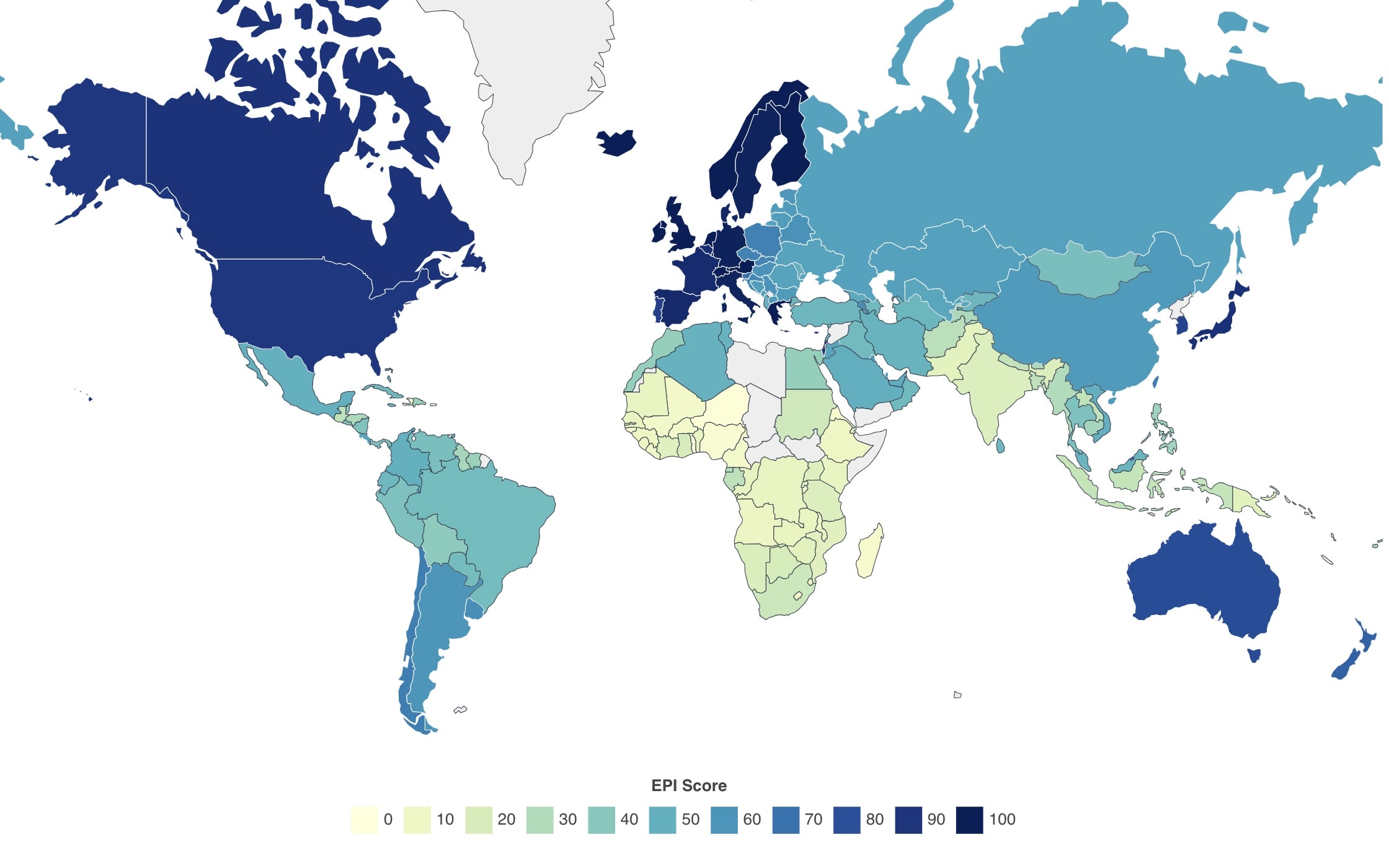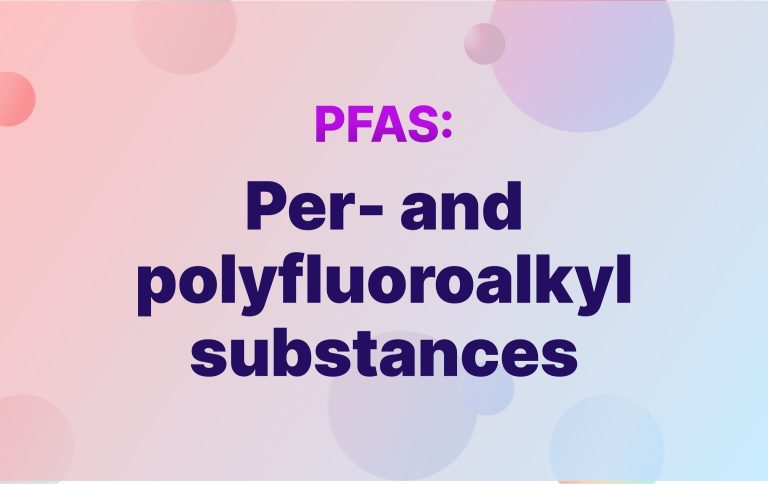Per- and polyfluoroalkyl substances (PFAS) are a large group of human-made chemicals that have been widely used in industry and consumer products since the 1940s. Often referred to as “forever chemicals” due to their extreme persistence in the environment.
PFAS have become a major focus of environmental and public health concern in recent decades as their widespread presence in the environment and potential health effects have come to light.
PFAS Chemical History Timeline
- 1938 – Roy Plunkett accidentally discovers polytetrafluoroethylene (PTFE) while working at DuPont.
- 1945 – DuPont trademarks PTFE as Teflon.
- 1950s – 3M begins manufacturing PFOA and PFOS.
- 1951 – DuPont starts using PFOA (C8) in Teflon production at Washington Works plant.
- 1956 – 3M introduces Scotchgard fabric protector using PFOS-based chemistry.
- 1961 – DuPont toxicologist warns that C8 is toxic and should be “handled with extreme care.”
- 1963 – U.S. Navy begins working with 3M to develop aqueous film-forming foams (AFFF).
- 1967 – U.S. Navy makes AFFF mandatory on vessels following USS Forrestal fire.
- 1970s – 3M documents presence of PFOS and PFOA in fish.
- 1978 – 3M builds seven incineration facilities for hazardous waste disposal across the United States.
- 1983 – 3M announces a $6 million cleanup of what would become known as the Oakdale Dump in Minnesota.
- 1998 – Lawyer Robert Bilott files lawsuit against DuPont on behalf of a West Virginia farmer.
- 1999 – EPA is first alerted to PFAS risks. EPA and 3M find PFOS contamination in blood banks around the country.
- 1999 – A farmer sues DuPont after scores of his cattle mysteriously die in Parkersburg, West Virginia, revealing PFOA dumping.
- 2000 – 3M announces voluntary phase-out of PFOA and PFOS production.
- 2001 – C8 Health Project is initiated to study health impacts of PFOA exposure.
- 2002 – 3M completes phase-out of PFOS production.
- 2002 – Minnesota Department of Health develops Health Based Values for PFOS and PFOA.
- 2003 – EWG discovers PFAS contamination is widespread, not limited to specific areas.
- 2004 – EPA files suit against DuPont for failing to report PFOA risks.
- 2005-2006 – C8 Health Project surveys nearly 70,000 people in Ohio and West Virginia.
- 2006 – EPA invites eight major PFAS manufacturers to join the PFOA Stewardship Program.
- 2009 – EPA establishes provisional health advisories for PFOA and PFOS in drinking water.
- 2010 – State of Minnesota sues 3M for natural resource damages from PFAS.
- 2013 – U.S. EPA includes PFOS and PFOA in Unregulated Contaminant Monitoring Rule 3 for public water systems.
- 2016 – EPA issues lifetime health advisories for PFOA and PFOS at 70 parts per trillion.
- 2016 – DuPont and Chemours settle over 3,500 lawsuits related to PFOA for $671 million.
- 2017 – Michigan creates the Michigan PFAS Action Response Team (MPART).
- 2018 – 3M settles with Minnesota for $850 million over PFAS contamination.
- 2018 – Release of the documentary “The Devil We Know” on Netflix, investigating PFOA health hazards.
- 2019 – Several states, including New Hampshire, file lawsuits against PFAS manufacturers.
- 2019 – EPA announces Per- and Polyfluoroalkyl Substances (PFAS) Action Plan.
- 2019 – Release of “Dark Waters” film, dramatizing Robert Bilott’s legal battle against DuPont.
- 2020 – Michigan enacts some of the strictest PFAS drinking water standards in the U.S.
- 2020 – EPA issues Preliminary Determinations to regulate PFOA and PFOS in drinking water.
- 2020 – Release of documentary “No Defense” highlighting widespread PFAS contamination in the U.S.
- 2020 – Australian government pays $212 million to settle PFAS contamination lawsuit.
- 2021 – EPA announces plans to regulate PFOA and PFOS in drinking water.
- 2021 – EPA announces PFAS Strategic Roadmap.
- 2022 – EPA drastically lowers health advisory levels for PFOA and PFOS to near-zero levels.
- 2022 – EPA proposes designating PFOA and PFOS as hazardous substances under CERCLA.
- 2023 – 3M agrees to pay up to $10.3 billion to settle U.S. public water system lawsuits.
- 2023 – Chemours, DuPont, and Corteva agree to $1.19 billion settlement for PFAS claims.
- 2023 – EPA proposes National Primary Drinking Water Regulation for six PFAS.
- 2023 – Announcement of documentary “How to Poison a Planet” featuring Mark Ruffalo.
- 2023 – 3M faces legal claims worth up to $58 billion for allegedly deceiving the public about PFAS risks.
- 2024 – EPA publishes final drinking water standards for PFOA, PFOS, PFHxS, PFNA, GenX, and PFBS.
Early Development and Commercialization (1930s-1950s)
The story of PFAS begins in the late 1930s with the accidental discovery of polytetrafluoroethylene (PTFE) by Roy Plunkett, a chemist working for DuPont. On April 6, 1938, Plunkett was conducting experiments with tetrafluoroethylene gas when he noticed that a cylinder of the gas had failed to discharge properly. Upon opening the cylinder, he found it was lined with a waxy white powder. This powder turned out to be polytetrafluoroethylene (PTFE), a polymer with remarkable properties including extreme heat resistance and a very low coefficient of friction.
DuPont began developing applications for this new material, which they trademarked as Teflon in 1945. PTFE’s non-stick and heat-resistant properties made it ideal for cookware coatings and other industrial applications. The development of PTFE marked the beginning of the fluoropolymer industry and paved the way for the creation of numerous other fluorinated compounds in the coming decades.
In the 1950s, 3M began manufacturing perfluorooctanoic acid (PFOA) and perfluorooctanesulfonic acid (PFOS), two of the most widely produced and studied PFAS compounds. These chemicals were used as processing aids in the production of fluoropolymers like PTFE and also found applications in a wide range of consumer products. 3M’s Scotchgard fabric protector, introduced in 1956, relied on PFOS-based chemistry to provide water and stain resistance.
DuPont also began using PFOA (which they referred to as C8) in the manufacturing process for Teflon in 1951 at their Washington Works plant in Parkersburg, West Virginia. These early years saw rapid growth in the production and use of PFAS as their unique properties found applications across numerous industries.
Expanding Use and Early Health Concerns (1960s-1990s)
Throughout the 1960s, 70s, and 80s, the use of PFAS expanded dramatically. They were incorporated into firefighting foams, food packaging, textiles, and numerous other products. The U.S. Navy began using aqueous film-forming foams (AFFF) containing PFAS for firefighting in 1966, and their use became widespread at military bases and civilian airports.
However, even as PFAS use was expanding, early signs of potential health and environmental concerns began to emerge. In 1961, a DuPont toxicologist warned that C8 was toxic and should be “handled with extreme care.” In 1963, 3M’s own studies on rats showed that PFOS could accumulate in the animals’ bodies. By 1970, DuPont had measured elevated levels of PFOA in the blood of workers at its Washington Works plant.
Despite these early warning signs, PFAS production and use continued to grow through the 1980s and early 1990s. The chemicals were not regulated, and their potential environmental and health impacts were not widely recognized outside of the companies producing them.
Growing Awareness and Initial Actions (Late 1990s-Early 2000s)
The late 1990s marked a turning point in the history of PFAS, as evidence of their widespread environmental presence and potential health effects began to accumulate. In 1997, 3M found PFOS in blood samples from blood banks around the United States, indicating widespread human exposure. In 1998, 3M provided the EPA with data showing that PFOS was toxic to rats and accumulated in their organs.
A pivotal moment came in 1999 when Robert Bilott, an environmental lawyer, filed a lawsuit against DuPont on behalf of a West Virginia farmer whose cattle had been dying after drinking water contaminated with PFOA from DuPont’s nearby Washington Works plant. This case would eventually lead to the release of thousands of pages of internal DuPont documents, revealing the company’s long-standing knowledge of potential health risks associated with PFOA.
In 2000, 3M announced it would voluntarily phase out production of PFOS and related compounds. This decision came after negotiations with the EPA, which had become increasingly concerned about the persistence and bioaccumulative potential of these chemicals. 3M’s announcement marked the beginning of a shift in the PFAS landscape, as regulatory scrutiny began to increase.
In 2001, attorney Robert Bilott sent a letter to the EPA and other regulatory agencies, summarizing the evidence of PFOA contamination and health risks based on the internal DuPont documents he had obtained. This letter helped catalyze EPA action on PFAS.
The C8 Health Project and Scientific Studies (2000s)
The early 2000s saw an increase in scientific research on PFAS and their potential health effects. In 2001, a highly cited paper by John Giesy and Kurunthachalam Kannan reported on the global distribution of PFOS in wildlife, demonstrating its widespread environmental presence and bioaccumulative properties.
A major development came in 2005-2006 with the initiation of the C8 Health Project. This large-scale epidemiological study, funded by DuPont as part of a legal settlement, examined the health impacts of PFOA exposure in nearly 70,000 people living near the Washington Works plant in West Virginia and Ohio. The study found probable links between PFOA exposure and six health conditions: kidney cancer, testicular cancer, ulcerative colitis, thyroid disease, hypercholesterolemia, and pregnancy-induced hypertension.
The findings of the C8 Health Project, along with other emerging research, significantly increased concern about the health impacts of long-term PFAS exposure. Studies in laboratory animals had already shown that PFOA and PFOS could cause developmental, reproductive, and other health effects. The human epidemiological evidence from the C8 study and others added weight to these concerns.
Regulatory Actions and Industry Response (2000s-2010s)
As scientific evidence of PFAS risks accumulated, regulatory agencies began to take action. In 2006, the EPA brokered a voluntary agreement with DuPont and seven other major companies to phase out the use of PFOA by 2015. This “PFOA Stewardship Program” led to a significant reduction in the production and use of long-chain PFAS in the United States.
However, as production of PFOA and PFOS decreased, companies began to shift to alternative PFAS compounds. For example, DuPont (later Chemours) developed “GenX” chemicals as a replacement for PFOA in the production of fluoropolymers. These shorter-chain PFAS were initially thought to be less bioaccumulative, but concerns about their environmental persistence and potential health effects have since emerged.
In 2009, the EPA established provisional health advisories for PFOA and PFOS in drinking water. In 2016, the agency issued more stringent lifetime health advisories of 70 parts per trillion for the combined concentration of PFOA and PFOS in drinking water. These advisories, while not enforceable regulations, provided guidance to state and local agencies and spurred further action on PFAS contamination.
The Department of Defense (DoD) also began to grapple with PFAS contamination related to the use of AFFF at military bases. In 2016, the DoD began widespread testing for PFAS in drinking water systems near its facilities. The results revealed extensive contamination, leading to increased pressure for cleanup and remediation efforts.
State-Level Actions and Growing Public Awareness (2010s)
As federal action on PFAS was seen as slow by many advocates, several states began to take their own regulatory actions. In 2018, New Jersey became the first state to establish enforceable standards for PFNA in drinking water, followed by standards for PFOA and PFOS in 2020. Other states, including Michigan, New Hampshire, and Vermont, have also established their own PFAS standards, often more stringent than federal guidelines.
The state of Minnesota played a particularly significant role in addressing PFAS contamination. In 2010, Minnesota filed a lawsuit against 3M for natural resource damages caused by PFAS pollution. This lawsuit was settled in 2018 for $850 million, with the funds designated for improving drinking water and natural resources in the affected area.
Public awareness of PFAS issues grew significantly during this period, driven by high-profile contamination cases, increased media coverage, and the release of films like “Dark Waters” (2019), which dramatized Robert Bilott’s legal battle against DuPont. Community advocacy groups formed in many areas affected by PFAS contamination, pushing for stricter regulations and cleanup efforts.
Recent Developments and Ongoing Challenges (2020s)
The 2020s have seen continued action on PFAS at both the federal and state levels. In 2021, the EPA announced a comprehensive strategy to address PFAS contamination, including plans to establish national drinking water standards for PFOA and PFOS, designate certain PFAS as hazardous substances under the Superfund law, and increase research on PFAS detection and treatment technologies.
In June 2022, the EPA dramatically lowered its health advisory levels for PFOA and PFOS in drinking water to near-zero levels (0.004 parts per trillion for PFOA and 0.02 parts per trillion for PFOS), reflecting growing concerns about the health impacts of even very low levels of exposure. The agency also issued final health advisories for GenX chemicals and PFBS.
Legal action against PFAS manufacturers has also intensified. In June 2023, 3M agreed to pay up to $10.3 billion to settle lawsuits over PFAS contamination of U.S. public water systems. This was followed by a $1.19 billion settlement agreement from Chemours, DuPont, and Corteva to resolve similar claims.
Despite these actions, PFAS contamination remains a significant environmental and public health challenge. The extreme persistence of these chemicals means that even with production phaseouts, they will remain in the environment for decades to come. Moreover, the shift to alternative PFAS compounds has raised new questions about the safety of these substitutes.
Thousands of different PFAS compounds exist, and many remain poorly studied. This has led some researchers and advocates to call for regulation of PFAS as a class, rather than addressing each compound individually. However, this approach faces challenges due to the diverse properties and uses of different PFAS.
Remediation of PFAS-contaminated sites presents another ongoing challenge. Traditional water treatment methods are often ineffective at removing PFAS, and new technologies for PFAS destruction and removal are still being developed and refined.
Scientific Understanding of PFAS
Over the decades, scientific understanding of PFAS has evolved significantly. Early research focused primarily on PFOA and PFOS, the two most widely used and studied PFAS compounds. These long-chain PFAS were found to be extremely persistent in the environment, bioaccumulative in wildlife and humans, and associated with a range of health effects in animal studies.
The C8 Health Project and other epidemiological studies have provided evidence of health effects in humans, including associations with kidney and testicular cancer, thyroid disease, high cholesterol, and pregnancy-induced hypertension. However, establishing definitive causal relationships between PFAS exposure and health outcomes in humans remains challenging due to the ubiquity of exposure and the long latency periods for some health effects.
As production of PFOA and PFOS has decreased, research attention has turned to alternative PFAS compounds, including shorter-chain PFAS like GenX chemicals and PFBS. While these compounds are generally less bioaccumulative, they can still be highly persistent in the environment. Some studies have suggested they may have similar toxicological effects to long-chain PFAS, although often at higher doses.
The mechanisms of PFAS toxicity are still not fully understood, but research has implicated several pathways. PFAS have been shown to activate peroxisome proliferator-activated receptors (PPARs), which play key roles in lipid and glucose metabolism. They may also interfere with thyroid hormone signaling and immune function.
One of the key challenges in PFAS research is the sheer number of compounds involved. While much research has focused on a handful of well-known PFAS, thousands of other compounds exist, many of which have been poorly characterized in terms of their environmental behavior and potential health effects.
Environmental Fate and Transport of PFAS
The environmental behavior of PFAS has been a major focus of research. These compounds are extremely persistent due to the strength of the carbon-fluorine bond, earning them the moniker “forever chemicals.” They do not readily biodegrade and are resistant to most conventional environmental remediation techniques.
PFAS can be transported long distances in water and air. They have been detected in remote Arctic environments, demonstrating their potential for long-range transport. In water, PFAS tend to associate with sediments and can accumulate in aquatic organisms. Some PFAS, particularly those with longer carbon chains, can bioaccumulate up the food chain.
The widespread use of PFAS in consumer products, industrial processes, and firefighting foams has led to numerous sources of environmental contamination. Major sources include industrial sites where PFAS were manufactured or used, military bases and airports where AFFF was used, and landfills where PFAS-containing products were disposed of. Wastewater treatment plants can also be significant sources, as conventional treatment processes do not effectively remove PFAS.
Current Challenges and Future Directions
As of 2024, PFAS contamination remains a significant environmental and public health challenge. While production of PFOA and PFOS has largely been phased out in many countries, these compounds persist in the environment and continue to be detected in human blood samples worldwide. Moreover, the shift to alternative PFAS compounds has raised new questions about the safety and environmental impact of these substitutes.
Key challenges include:
- Remediation: Developing effective and economically feasible methods for cleaning up PFAS-contaminated sites remains a major challenge. While some technologies show promise, such as granular activated carbon filtration and ion exchange resins, they often struggle to remove shorter-chain PFAS effectively.
- Regulation: Determining appropriate regulatory standards for PFAS is complicated by the large number of compounds involved and ongoing scientific uncertainty about their health effects. Some advocates argue for regulating PFAS as a class, while others argue for compound-specific approaches.
- Alternative Materials: Finding safe, effective alternatives to PFAS for various industrial and consumer applications is an ongoing challenge. While some PFAS-free alternatives have been developed, they may not always match the performance of PFAS-based materials.
- Ongoing Exposure: Even with production phaseouts, humans and wildlife continue to be exposed to PFAS through legacy contamination, imported products, and the breakdown of precursor compounds.
- Health Effects: Further research is needed to fully understand the long-term health effects of PFAS exposure, particularly for newer PFAS compounds and mixture effects.
Looking to the future, several key areas of focus are emerging:
- Improved Analytical Methods: Developing more sensitive and comprehensive analytical methods to detect and quantify the full range of PFAS compounds in environmental and biological samples.
- Novel Remediation Technologies: Research into new methods for destroying PFAS, such as electrochemical oxidation and plasma treatment, shows promise for more effective cleanup of contaminated sites.
- Green Chemistry: Efforts to develop non-fluorinated alternatives that can match the performance of PFAS in various applications without the associated environmental and health risks.
- Biomonitoring and Epidemiology: Continued long-term studies to track PFAS levels in human populations and better understand potential health effects.
- Regulatory Harmonization: Efforts to develop more consistent regulatory approaches to PFAS across different jurisdictions and to address PFAS as a class of chemicals.
The history of PFAS chemicals is a complex tale of scientific innovation, widespread commercialization, and growing environmental and health concerns. From their accidental discovery in the 1930s to their current status as a global environmental contaminant, PFAS have left an indelible mark on our world. The story of PFAS illustrates the challenges of managing persistent, bioaccumulative chemicals in a globalized economy and highlights the importance of considering long-term environmental and health impacts in chemical regulation.
As we move forward, addressing the PFAS challenge will require continued scientific research, technological innovation, and collaborative efforts between government, industry, and communities. The lessons learned from the PFAS story may help inform more sustainable approaches to chemical development and use in the future, emphasizing the need for thorough safety testing, transparency, and consideration of long-term environmental impacts before widespread deployment of new chemicals.





